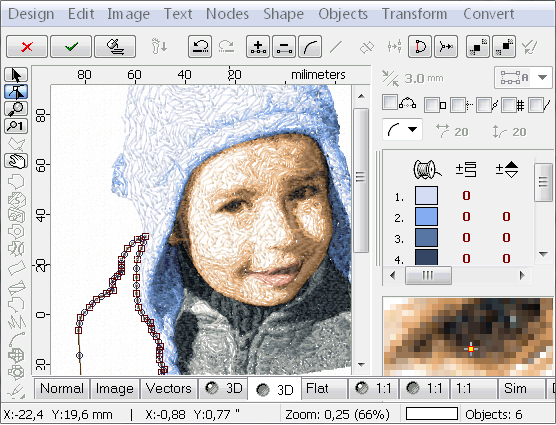Simplifying the Art of Embroidery Digitizing: Step-by-Step Guide
Needlework digitizing is a thorough craft that requires precision and creativity. As technology proceeds to advancement, the digitization process has actually come to be a lot more easily accessible, permitting enthusiasts to bring their intricate layouts to life with convenience. In this guide, we will untangle the complexities of embroidery digitizing, breaking down each step carefully to simplify the process and equip both beginners and skilled embroiderers alike. Remain tuned to find exactly how you can streamline this complex art form and change your innovative visions right into perfectly embroidered work of arts.
Recognizing Needlework Digitizing Software Application
Needlework digitizing software application functions as a vital tool for changing detailed designs into electronic layouts compatible with embroidery devices, helping with specific stitching and personalization. This customized software program enables customers to import various picture documents layouts, such as JPG or PNG, and convert them right into needlework machine-readable formats like DST, EXP, or PES - Digitizing for Embroidery. By using attributes like stitch editing, padding alternatives, and string shade selection, digitizing software application allows customers to regulate every element of the style procedure
Moreover, advanced embroidery digitizing software supplies devices for developing complex designs, adjusting stitch density, and integrating elaborate details. Users can also preview the design prior to stitching it out, guaranteeing accuracy and lessening errors. Furthermore, several software application supply automated functions that help improve the digitizing process, conserving effort and time.
Understanding the capabilities of needlework digitizing software program is important for achieving high-quality cause needlework jobs. By mastering this tool, needlework fanatics and professionals can release their creative thinking and bring complex styles to life with precision and efficiency.

Selecting the Right Style Data
After acquainting on your own with the abilities of needlework digitizing software application, the following critical action in the process is selecting the ideal style apply for your task. Digitizing for Embroidery. When picking a style declare needlework digitizing, it's important to think about the complexity of the layout, the dimension of the final product, and the type of material you will be functioning with
For detailed styles with fine information, a high-resolution picture or vector documents is advised to make sure that the embroidery machine can properly replicate the layout. Additionally, the dimension of the final product plays a substantial function in selecting the best design documents. Larger designs might require higher resolution files to keep clarity and intensity.
Additionally, the sort of material you will certainly be embroidering on influences the selection of design data. Various materials might require modifications in the layout file to make sure that the stitches are effectively straightened and the design looks like meant. By carefully choosing the ideal layout data based upon these variables, you can set yourself up for a successful embroidery digitizing procedure.
Digitizing Tools and Techniques
Using specialized software application and accuracy techniques, digitizing tools are crucial in transforming intricate great site styles into embroidery-ready data. Needlework digitizing software program, such as Wilcom, Hatch, or Embrilliance, supplies the essential system to transform art work right into stitch information. These programs supply functions like stitch modifying, rug alternatives, and text devices to make sure the design converts flawlessly onto textile.
Among the key techniques in digitizing is creating a clear path for the needlework equipment to adhere to. This entails digitizing each component of the layout with accuracy, determining stitch kinds, thickness, and instructions. By utilizing tools like digitizing tablet computers or software-specific plugins, embroiderers can attain a high level of accuracy in their digitized styles.
In addition, grasping the art of padding sewing is vital for creating quality embroidery. Underlay sewing supports the material and creates a structure for the layout, making sure that the end product is both visually enticing and durable. By understanding these digitizing tools and techniques, embroiderers can boost their craft and bring complex styles to life with precision and efficiency.
Tailoring Stitch Types and Directions
Having developed a structure in digitizing devices and strategies, moved here an essential element beforehand embroidery workmanship depends on customizing stitch kinds and instructions with accuracy and objective. The choice of stitch types can significantly influence the total look and texture of the stitched layout. Satin stitches, understood for their smooth and shiny finish, job well for creating boundaries and message. On the various other hand, fill stitches are excellent for covering larger locations effectively. By tactically combining these stitch types, embroiderers can attain deepness and dimension in their designs.
Additionally, the instructions of stitches plays a crucial duty in enhancing the visual appeal of the final embroidery. By experimenting with different stitch angles and patterns, embroiderers can bring their designs to life with exceptional information and details.
Screening and Refining Your Digitized Layout
To make certain the precision and top quality of your digitized layout, complete testing and refinement are important steps in the embroidery digitizing procedure. As soon as you have finished the digitization of your layout, it is critical to examine it prior to waging the actual needlework. Testing permits you to recognize any type of prospective issues such as string breaks, stitch density troubles, or design distortions that might impact the outcome.

After testing, it is essential to improve your digitized layout based on the feedback from the examination sew-out. This might entail tweaking sew settings, adjusting thickness, or making modifications to the general design to attain the preferred outcome. By repeating with testing and improvement, you can tweak your digitized design to excellence prior to moving on with the real embroidery procedure.
Final Thought
To conclude, grasping the art of embroidery digitizing calls for a comprehensive understanding of the software, choosing the right layout data, using digitizing devices and methods, customizing stitch kinds and directions, and screening and refining the digitized style. By complying with these steps, embroiderers can streamline the digitizing process and develop premium stitched styles with accuracy and efficiency.